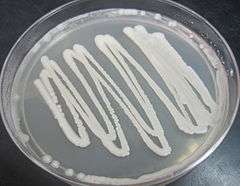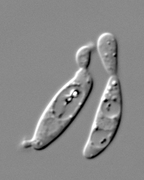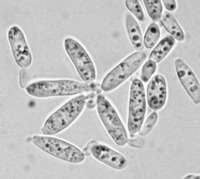Kriegeriales
| Kriegeriales | |
|---|---|
 | |
| Meredithblackwellia eburnea in culture | |
| Scientific classification | |
| Kingdom: | Fungi |
| Division: | Basidiomycota |
| Subdivision: | Pucciniomycotina |
| Class: | Microbotryomycetes |
| Order: | Kriegeriales Toome & Aime (2013)[1] |
| Subdivisions | |
|
| |
Kriegeriales is an order of Fungi that are mostly yeasts and can be found from a variety of places, ranging from arctic waters to tropical ferns.
Taxonomy
Most of the species now recognized as being members of Kriegeriales were for a long time placed as incertae sedis (meaning that the exact placement is unknown) in class Microbotryomycetes.[2] Recently, the order was described based on evidence from DNA sequence data that showed that a newly discovered Neotropical yeast genus and species, named Meredithblackwellia eburnea, was closely related to several unplaced species in genera Kriegeria, Camptobasidium and Glaciozyma and some other basidiomycete yeasts.[1] Kriegeriales is divided into two families: Kriegeriaceae and Camptobasidiaceae. Camptobasidiaceae was described by R.T. Moore who placed it in Atractiellales[3] However, DNA sequence data has now shown that Camptobasidium belongs to Microbotryomycetes rather than Atractiellomycetes.[4] To date there are two genera described in Kriegeriaceae, Kriegeria and Meredithblackwellia, and two in Camptobasidiaceae, Camptobasidium and Glaciozyma.[1]
Morphology
Most of the known species and strains of Kriegeriales are asexually reproducing yeasts that don’t have a known sexual state. All are white or cream colored, with elongated cells that reproduce by budding at either end. A handful of species have been studied in greater detail and for these it has been shown that the nuclear division of the yeast state occurs in the bud,[1][5] a common character shared with most other basidiomycete yeasts.[6] However, in M. eburnea, K. eriophori and Rhodotorula rosulata budding cells remain attached to each other at the base, forming characteristic clusters of cells that are otherwise unknown in basidiomycete yeasts.[1][5][7] The species in Glaciozyma differ in that these are yeasts with a known sexual state.[8] Only two members of Kriegeriales (K. eriophori and C. hydrophilum) are known to form hyphal cells (elongated cells that are characteristic of most other basidiomycetes). Of these, K. eriophori also has an asexual yeast state,[5] leaving C. hydrophilum as the only species in the entire order that is hyphal throughout its life cycle.[9] Ultrastructural studies of these two hyphal species have determined that they have simple septal pores, as is true for all other known Pucciniomycotina.[2]
|
Habitat and distribution
Species of Kriegeriales can be found in a variety of ecological niches. The members known to date include plant parasites (K. eriophori), aquatic fungi (C. hydrophilum), saprobes, or have unknown roles in nature. Some have been isolated from psychrophilic environments and are associated with glaciers or the Antarctic sea.[8][10] For example Glaciozyma antarctica (formerly known as Leucosporidium antarcticum) was one of the first basidiomycete yeasts ever isolated from the Antarctic sea.[11] Others have been isolated from the leaf surfaces of various plants both from temperate and tropical regions; their role in these habitats is unknown.[1][7]
Known members of Kriegeriales
Family Kriegeriaceae:
- Kriegeria eriophori ( = Zymoxenogloea eriophori)
- Meredithblackwellia eburnea
- Rhodotorula glacialis
- Rhodotorula himalayensis
- Rhodotorula pilatii
- Rhodotorula psychrophenolica
- Rhodotorula psychrophila
- Rhodotorula rosulata
- Rhodotorula sp. KRP3844
- Rhodotorula sp. FK.2.1
- Rhodotorula sp. CBS11784
Family Camptobasidiaceae:
- Camptobasidium hydrophilum
- Glaciozyma antarctica (= Leucosporidium antarcticum)
- Glaciozyma watsonii
- Glaciozyma martinii
- Leucosporidium sp. AY30
References
- 1 2 3 4 5 6 Toome M, Roberson RW, Aime MC. 2012. Meredithblackwellia eburnea sp. et gen. nov., Kriegeriaceae fam. nov. and Kriegeriales ord. nov. – toward resolving higher-level classification in Microbotryomycetes. Mycologia 105: DOI: 10.3852/12-251
- 1 2 Bauer R, Begerow D, Sampaio JP, Weiss M, Oberwinkler F, 2006. The simple-septate basidiomycetes: a synopsis. Mycological Progress 5: 41–66.
- ↑ Moore RT, 1996. An inventory of the phylum Ustomycota. Mycotaxon 59: 1–31.
- ↑ Aime MC, Matheny PB, Henk DA, Frieders EM, Nilsson RH, Piepenbring M, McLaughlin DJ, Szabo LJ, Begerow D, Sampaio JP, Bauer R, Weiss M, Oberwinkler F, Hibbett DS, 2006. An overview of the higher-level classification of Pucciniomycotina based on combined analyses of nuclear large and small subunit rDNA sequences. Mycologia 98: 895–905.
- 1 2 3 McLaughlin DJ, Frieders EM, Berres ME, Doublés JC, Wick SM, 1996. Immunofluorescence analysis of the microtubule cytoskeleton in the yeast phase of the basidiomycetes Kriegeria eriophori and Septobasidium carestianum. Mycologia 88: 339-349.
- ↑ McCully EK, Robinow CF, 1972. Mitosis in heterobasidiomycetous yeasts. I. Leucosporidium scottii (Candida scottii). Journal of Cell Science 10: 857-881.
- 1 2 Golubev WI, Scorzetti G, 2010. Rhodotorula rosulata sp. nov., Rhodotorula silvestris sp. nov. and Rhodotorula straminea sp. nov., novel myo-inositol-assimilating yeast species in the Microbotryomycetes. International Journal of Systematic and Evolutionary Microbiology 60: 2501–2506.
- 1 2 Turchetti B, Thomas Hall SR, Connell LB, Branda E, Buzzini P, Theelen B, Müller WH, Boekhout T, 2011. Psychrophilic yeasts from Antarctica and European glaciers: description of Glaciozyma gen. nov., Glaciozyma martinii sp. nov. and Glaciozyma watsonii sp. nov. Extremophiles 15: 573–586.
- ↑ Marvanová L, Suberkropp K, 1990. Camptobasidium hydrophilum and its anamorph, Crucella subtilis: a new heterobasidiomycete from streams. Mycologia 82: 208–217.
- ↑ Margesin R, Fonteyne PA, Schinner F, Sampaio JP, 2007. Rhodotorula psychrophila sp. nov., Rhodotorula psychrophenolica sp. nov. and Rhodotorula glacialis sp. nov., novel psychrophilic basidiomycetous yeast species isolated from alpine environments. International Journal of Systematic and Evolutionary Microbiology 57: 2179–2184.
- ↑ Fell JW, Statzell AD, Hunter IL, Phaff HJ. 1969. Leucosporidium gen. n., the heterobasidiomycetous stage of several yeasts of the genus Candida. Antonie van Leeuwenhoek 35: 433-462.

